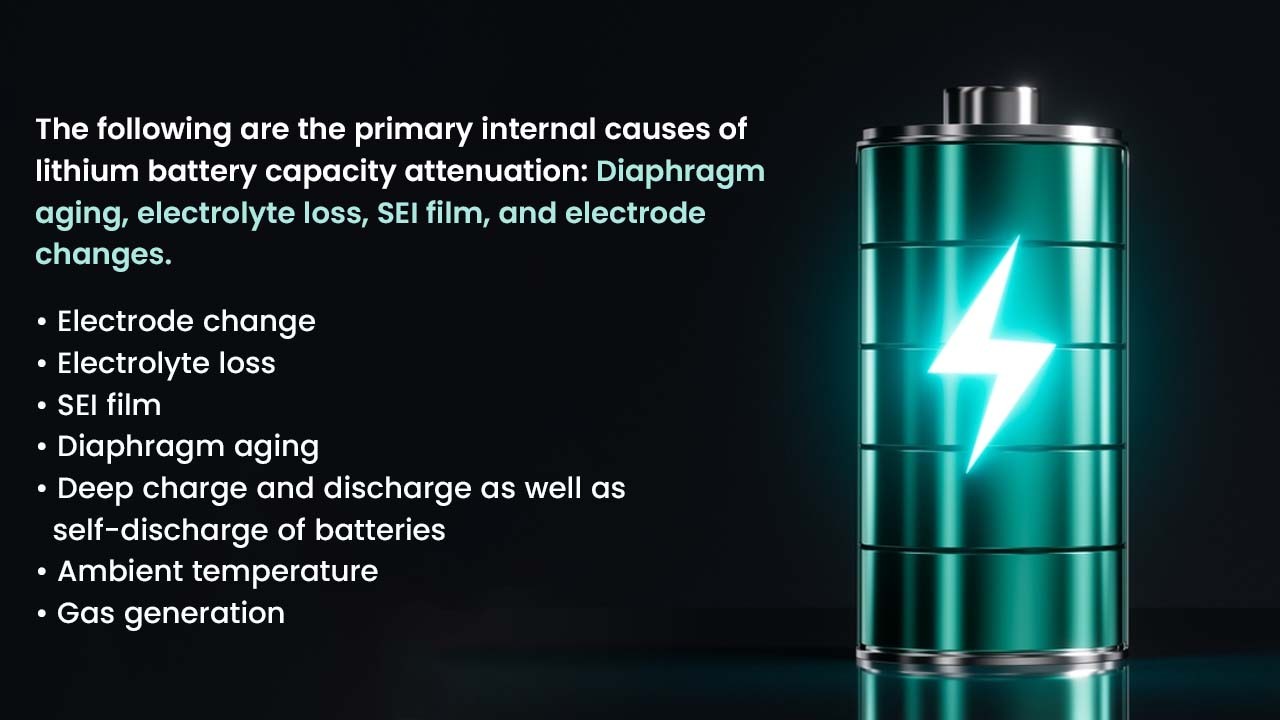
Lithium-ion power battery is a complex system composed of positive and negative electrodes, positive and negative electrodes, electrolyte and diaphragm. The only thing that should happen is the implantation and release of ions between the electrolytes and positive and negative electrodes. There are no other adverse effects observed. The reaction does not result in the loss of lithium ions, nor will the battery’s capacity.
However, in real life, side effects will happen inside the battery in addition to lithium-ion embedding and ejection. Lithium-ion loss, electrolyte loss, active substance consumption, and ultimately attenuation of battery capacity are all consequences of the side reaction. There are two main categories of causes for battery capacity attenuation: internal and external.
The following are the primary internal causes of lithium battery capacity attenuation: diaphragm aging, electrolyte loss, SEI film, and electrode changes.
- Electrode change: Variations in battery capacity occur as a result of the loss of active materials, the substitution of positive materials, and the alteration of collector fluidity during the battery cycle. The electrode material will break down as a result of adverse reactions. The expansion of the positive material structure brought on by the embedding and release of lithium ions will also affect the battery capacity by preventing the de-embedding of lithium ions and causing a phase change in the positive material structure.
- Electrolyte loss: The side reaction in the battery will use up the electrolyte material during the battery cycle, which will have an impact on the battery’s capacity.
- SEI film: When a battery first starts to run, its electrolyte and electrode will react to create a solid electrolyte film. The SEI film’s chemical properties are stable, and subsequent reactions will be coordinated following the formation of the electrode-electrolyte interface. Although lithium ions can embed and release on the electrode through the SEI membrane, stress will cause the membrane to burst, resulting in the rapid generation of a new SEI film. The loss of lithium ions and electrolyte as well as the eventual attenuation of battery capacity are caused by the formation, rupture, and repair of the SEI membrane.
- Diaphragm aging: The diaphragm keeps the battery’s positive and negative electrodes apart and guards against internal short circuits. The diaphragm should ideally remain unchanged. But the battery side reaction will lead to the electrolyte’s breakdown, which will impact the diaphragm’s electrochemical and mechanical characteristics. This will raise the battery’s ohm resistance, reduce its capacity, and shorten its lifespan.
The production of gas, ambient temperature, deep charge and discharge of the battery, and battery self-discharge are the primary external causes of lithium battery capacity attenuation.

- Deep charge and discharge as well as self-discharge of batteries: A retant battery will gradually discharge on its own. A chemical process called self-discharge takes place within the battery. Lithium ions and electrolyte will be consumed in this reaction, which will also produce substances that are insoluble in electrolyte and adhere to its surface, thereby influencing the embedding and release of lithium ions. Similar to deep discharge, overcharging, and deep discharge, excess lithium ions will also be produced by the positive and negative electrodes. The electrolyte and lithium ions react, and the resultant product influences the release and embedding of lithium ions. Both will ultimately result in a lower capacity and shorter lifespan for the battery.
- Ambient temperature: At low temperatures, the electrolyte’s conductivity will quickly decrease, lowering the battery’s capacity. The electrolyte and electrode materials will break down at high temperatures, and this breakdown will immediately lower the battery’s capacity.
- Gas generation: As a result of side reactions that may occur during battery use, the battery may produce additional liquids or gases, which could lead to uneven internal air pressure and a decrease in battery capacity.
The battery capacity can also be impacted by additional factors. For instance, poor battery design, issues with the manufacturing process, and incorrect use will result in a reduction in battery capacity. Unreasonable design, for instance, could result in an unstable internal structure or other battery defects; issues with the manufacturing process could cause an uneven distribution of electrode materials or electrolyte leakage; and improper use could expose the battery to unfavorable conditions like over discharge, overcharging, or high temperatures.
In conclusion, a variety of factors work together to reduce the capacity of lithium-powered batteries. We must be mindful of the use conditions, maintenance, and proper usage of the battery in order to preserve its capacity and lifespan. Simultaneously, it is anticipated that as science and technology continue to advance, more sophisticated battery technology and maintenance techniques will be developed to extend battery life and enhance performance.

